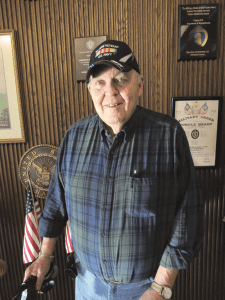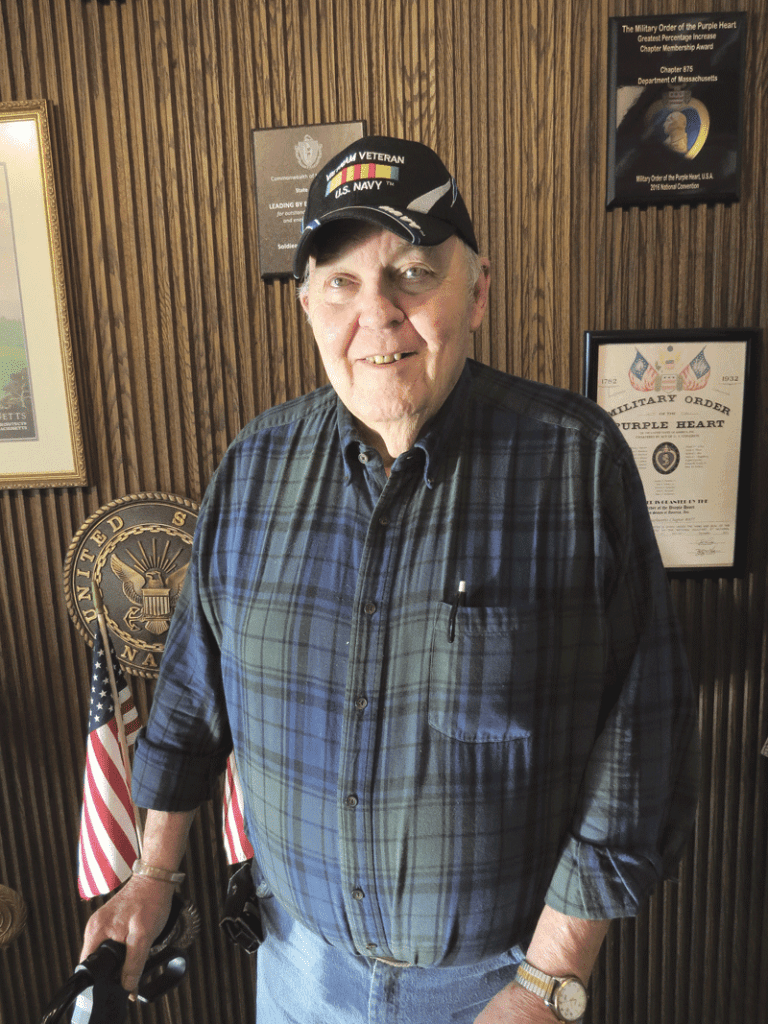On the Home Front – Holyoke Facility Serves as a Unique Safety Net for Veterans

Bennett Walsh was searching for some words he thought he could sum up the purpose, or mission, of the Soldiers’ Home in Holyoke and, more importantly, what it means to the veterans who reside there and their families.
He eventually summoned the phrase ‘safety net,’ and would use it several times in the course of a discussion about this state-funded long-term-care facility’s past, present, and likely future. And in many ways, that works.
“People come here because, for one of a variety of reasons, the family cannot provide the 24/7 care that their loved one needs,” said Walsh, a retired Marine lieutenant colonel who was named superintendent of the facility just before Memorial Day last May. “We’re a facility that can provide that. In many cases, a husband loses his wife, and she was the primary caregiver. Now that she’s gone, there’s no one in the family that can care for him 24/7. Every veteran here has a different story, but it all starts with a need that we can meet.”
But to those who call this facility home, it is much more than a safety net. For some perspective, HCN talked with Ted Dickson, a submariner who served on the USS Snook, a nuclear-powered Skipjack-class vessel, during the Vietnam War. He suffered a brain aneurism two years ago, underwent surgery at Leahy Clinic, recuperated at several hospitals, and then spent some time in a local nursing home.
It was that last stop that he used as a launching point for his comments about the Soldiers’ Home, which he moved to roughly a year ago.
“I didn’t like that experience at all,” he said of his time in the nursing home before quickly changing the subject to his present surroundings. “It’s much different here … you have the freedom to do what you want, and there are so many activities. But you’re also surrounded by other people who served, and it’s great to be around these people.”
Elaborating, he said that, while the more than 250 veterans living at the facility share a number of common threads and can — and do — share many war stories (in this case, in a literal sense), that’s just part of the equation.
Other parts include the atmosphere, the camaraderie, the compassionate staff, the myriad activities the veterans can participate in —Dickson himself partakes in everything from photography to watercolor painting — and the many events, on site and off, that those at the Soldiers’ Home become part of.
Indeed, they don’t celebrate Veterans Day at the facility, said Walsh; instead, they commemorate what has become known as ‘Veterans Month.’
“Actually, every day is Veterans Day here,” said Walsh, adding that this mindset, or operating philosophy, if you will, is one of the reasons why the facility is a popular choice for those who have served, and their families.
“Every day in November, there was something going on — not only here at the home, but also out in the community that our veterans were asked to attend,” he said while trying to explain some of the many elements that set this facility apart. “It was heartwarming to see the amount of outpouring from all the different groups in the community; the message was clearly sent that our veterans are not forgotten.”
But while the Soldiers’ Home, opened in 1952, has a proud history, a mission that clearly resonates, and a seemingly solid future, there are challenges, said Walsh, whose successor left the facility due to what he considered weak support from the state, compared to what it provides to a much larger sister facility in Chelsea.
Walsh believes the Holyoke facility is adequately funded — “could I use more money? Ask anyone that question, and they would say ‘yes’” — and that the challenge is to make the most of the resources it has and create greater efficiencies, especially since the facility is now nearly 65 years old and certainly showing its age.
“We have to do better and be smarter,” he explained, adding that this mindset has many components, including greater use of clean energy. “We need to ensure that we’re using every dollar properly because, while this facility has great bones and great structure, when it reaches this age, there are challenges.”
For this issue and its focus on healthcare, HCN visited the Soldiers’ Home and talked with its new superintendent to gain some perspective on its unique mission and how it carries out that all-important assignment.
Branch Office
Walsh is in the process of having his office painted, and one of the first steps in that process is to take down much of the collection of plaques, pictures, awards, and other items he’s collected over the years.
Collectively, they tell quite a story, one of a 25-year career in the Marines that saw duty with each of that branch’s fabled divisions and in nearly all of the notable hot spots since the early ’90s.
Indeed, he was an infantry platoon commander in Mogadishu, Somalia and completed three tours of duty in Iraq and one in Afghanistan. He was stationed on Okinawa when a tsunami slammed into Northern Japan in 2011, and was among those troops assigned to aiding in the recovery from that disaster.
“I was stationed there for 30 days and could feel the aftershocks,” he recalled, adding that, when his time with the Marines ended early last year, he was faced with the often-challenging assignment of determining what comes next. As he looked back, he said that administering a long-term-care facility for veterans wasn’t exactly on his immediate radar screen.
In fact, one of his first interviews was with MGM concerning a possible security-consulting assignment with the casino due to open in September 2018, and another concerned a similar assignment with United Technologies.
But upon hearing about the opening at the Soldiers Home, and with some prodding from family and friends, he decided to explore that option.
“I was actively interviewing for life after the Marine Corps — the next act, as I like to say — and I was approached about this position, which appealed to me because I would get to work with veterans,” said Walsh, who is now serving on the home front, in every sense of that phrase.
Since arriving, he’s spent the requisite considerable amount of time and energy needed to acquaint himself with everything from the staff of 300 to the veterans themselves (he knows most all of them on a first-name basis), to the facility’s rich history.
Relating some of the latter, he said the facility — a converted mental-health hospital built on a former apple orchard on a hill on Cherry Street with a commanding view of the Paper City — was built with the intention of serving the nation’s many World War I veterans, who, by the early 1950s, were likely in their 60s or 70s.
Over the years, the composition of the group residing in the home has naturally changed, and it continues to do so, said Walsh, noting that, while the bulk of current veterans served in World War II or the Korean War, there are a large number of Vietnam War vets, now in their early 60s at the youngest, as well. And there are many who served in peacetime in various locations around the world.
“Overall, it’s a very intriguing mix of people, and what they all have in common is that they served their country,” said Walsh, adding that the average age of the residents, as it is in most long-term facilities, is just over 80.
Most are from Western Mass., which is the unofficial service area of the Holyoke facility, he went on, adding that this means all four counties. But some are also from the central and eastern parts of the state as well.
The home, which serves more than 2,000 veterans a year through a host of inpatient and outpatient services, including dental and lab work and a pharmacy, is generally fully occupied, and there is a waiting list.
All branches of the service are well-represented, said Walsh, referring to the Army, Navy, Air Force, Marines, Coast Guard, and Merchant Marine. And veterans currently in residence have taken part in a host of landmark battles and campaigns, including Pearl Harbor, the Battle of the Bulge, the Normany invasion, and the Manhattan Project that brought about the atom bomb.
“There is a lot of history represented here,” said Walsh.
Most veterans will spend two to three years at the facility, on average, he said, adding that veterans are charged $30 per day ($900 per month) to stay there, with most of the costs offset by veterans benefits.
Battle Plan
As noted earlier, the care provided at the Soldiers’ Home is 24/7 in nature, which makes the facility similar to a typical long-term-care facility.
But, given the unique nature of the client base, that is where most of the comparisons end, said Walsh.
Indeed, while each of the veterans living there has a story — both in terms of their service to their country and how they arrived in Holyoke — that is in some way different, there are those abundant common denominators, especially a desire to be among fellow service men and women and enjoy a host of programs and activities simply not available at a traditional nursing home.
‘Veterans Month’ is just part of that equation, Walsh said, adding that there are events all year, and a number of special programs (including successful efforts to make the home a voting place last November) designed to make sure that veterans and their service are not forgotten.
That includes those who fought in what some have come to call the ‘forgotten war,’ the one waged in Korea just as the Soldiers’ Home in Holyoke was opening its doors.
“This year they marked the 50th anniversary of the Vietnam War, and there were special pins made up for all our Vietnam veterans,” he explained. “But we made the decision that we didn’t want to forget the Korean War veterans, so we made up special pins for them as well and had a ceremony earlier this month.”
It was this unique environment and focus on veterans that certainly appealed to Dickson, 73, whose story, at least the the chapter relating to the Soldiers’ Home, began a few years ago, when, as he colorfully put it, “my wife thought I was acting a little wacky.”
Her instincts proved correct, because an MRI revealed an aneurism, which led to surgery at the Leahy Clinic that “took a chunk out of my head and pulled out the aneurism.”
As Dickson said, his stay in a traditional nursing home was not enjoyable, and an examination of options revealed that the Soldiers’ Home was one of them, and he took full advantage of that opportunity.
“It’s been a super experience — it’s nice to be in the middle of a group like that,” he said, adding that, while he’s receiving care, he likes to give back — to both those providing the care and the community at large, through everything from his photography to events for veterans in area cities and towns.
The goal moving forward, said Walsh, is to simply write more stories like Dickson’s, an assignment that comes with many challenges.
And that’s why another of Walsh’s first priorities is to create a long-term strategic plan for the facility, one that will ensure that it can live up to its unofficial operating slogan, “providing quality care with honor and dignity.”
“You have to look forward because, if you don’t, you’re not looking ahead,” he explained. “A big part of our five-year strategy is to make better use of our existing resources.”
Soldiering On
On the day he talked with HCN, there was a Santa Claus suit hanging on a rack in the corner of Walsh’s office.
He acknowledged that, in his present role, he wears many different hats — and in this case, a red wool one, as he distributed gifts to veterans and their family members at the annual holiday party.
The Santa suit — not to mention the jacket and tie he wears most days — is quite a departure from the Marine camos he’s been wearing for more than half his life. But he sees it simply as service, or, to be more precise, as a continuation of service, to both the country and others who have answered the call.
Providing that service in the form of a unique environment featuring specialized 24/7 care is what the Soldiers’ Home is all about. And that’s what makes it a safety net, but also much more.
Just ask Ted Dickson — or anyone else who calls this place ‘home.’



Comments are closed.